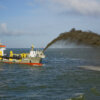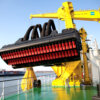“Facts About Trailing Suction Hopper Dredgers” describes self-propelled hydraulic dredgers with drag heads that suction up loose materials like sand.
Trailing suction hopper dredgers (TSHDs) are hydraulic dredgers, which make use of centrifugal pumps for at least part of the transport process of moving the dredged materials, either by raising material out of the water or horizontally transporting material to another site.
They are self-propelled ships that contain a hopper or hold inside their hulls and are primarily used for dredging loose material such as sand, clay or gravel. The main features of a “trailer” are drag heads, suction pipes, swell compensators and gantries.
Typically a trailing suction hopper dredger is equipped with one or two suction pipes to which the drag heads are attached. A drag head is often compared to a giant vacuum cleaner. The suction pipes are lowered underwater and the drag heads are “dragged” over the seabed, sucking up material as the ship slowly moves forward, that is, trails.
Once fully loaded, the vessel sails to the unloading or placement site where the dredged material is offloaded. Depending on the type of project, the dredged material will be offloaded/discharged in one of three ways:
- material is deposited at the placement site by opening hatches underneath in the ship’s hull,
- material may be pumped ashore through submerged or floating pipelines, or
- material may be propelled by heavy duty pumps into the air, a process known as rainbowing.
The method of offloading or discharging is directly related to the type of project.
Trailing suction hopper dredgers are amongst the most flexible dredging plant available. This is evident in the types of material they can dredge, where this material can be placed and where they can work. Because they are self-propelled, seaworthy vessels they are ideal for use in major land reclamation projects where enormous quantities of fill are needed. This self-sufficiency allows them to dredge the material from distant borrow areas and discharge it where needed without any other support equipment.
“Facts About Trailing Suction Hopper Dredgers answers essential questions such as:
- What is a trailing suction hopper dredger?
- When are trailing suction hopper dredgers used?
- What characterises a trailing suction hopper dredger?
- What types of drag heads are available?
- What is a ripper drag head?
- What does a suction pipe do?
- What is an overflow system?
- How do TSHDs offload or discharge dredged material?
- When to discharge through bottom doors?
- When to discharge through a pipeline?
- What is rainbowing?
- What factors influence a tshd when rainbowing?
- When is rainbowing appropriate?
- How big is a trailing suction hopper dredger?
- What are the advantages of trailing suction hopper dredgers?
- How accurate is a trailing suction hopper dredger?
- What are environmental concerns when using a trailing suction hopper dredger?
- What safety factors are considered?
- Is sound a factor with a trailing suction hopper dredger?
- When is a trailing suction hopper dredger the appropriate choice for a dredging project?







